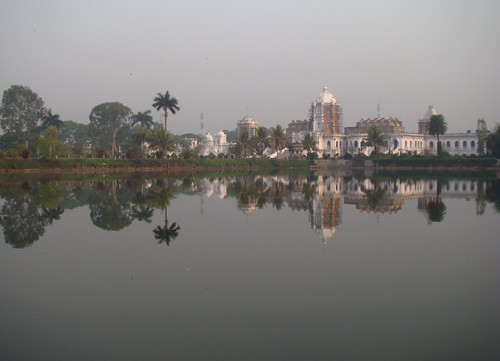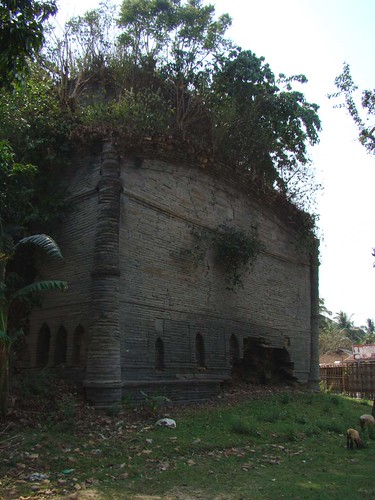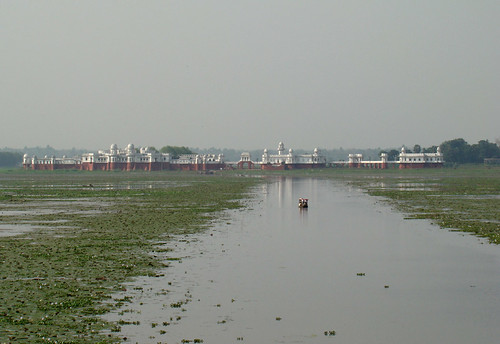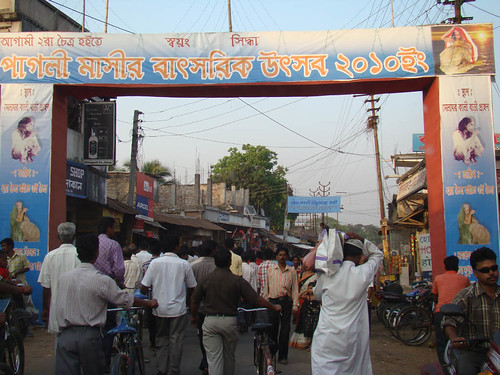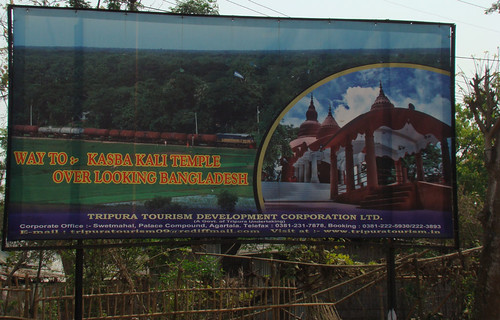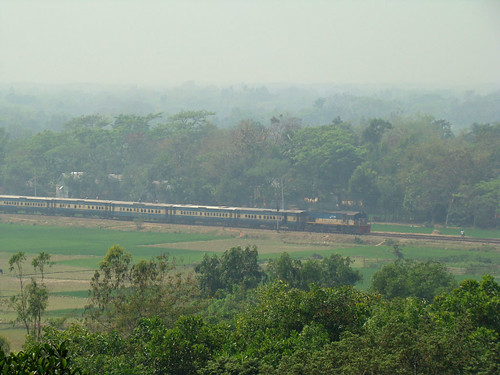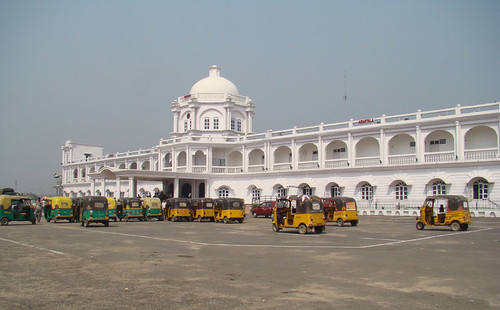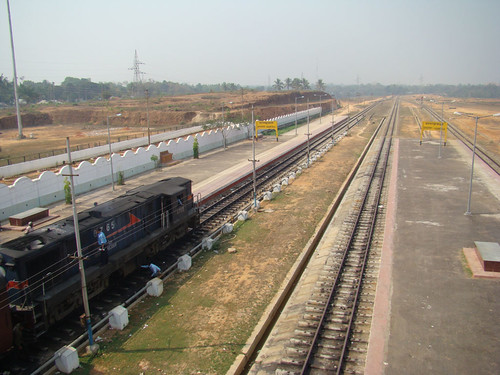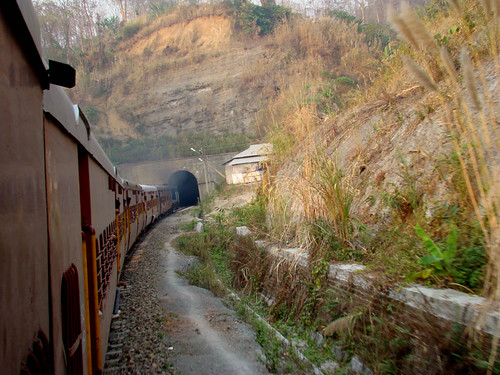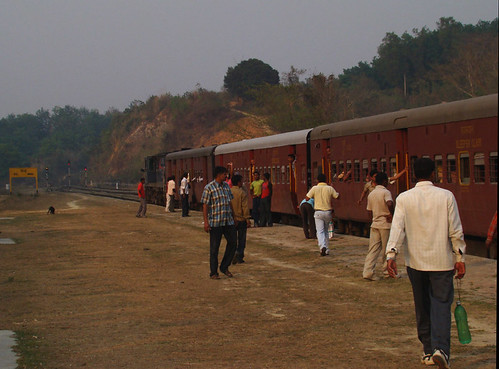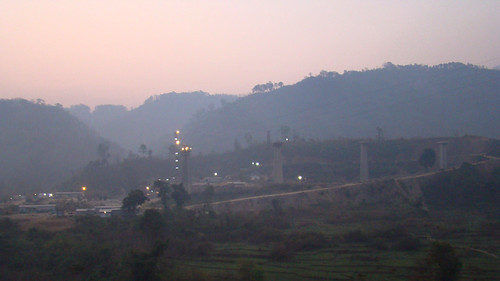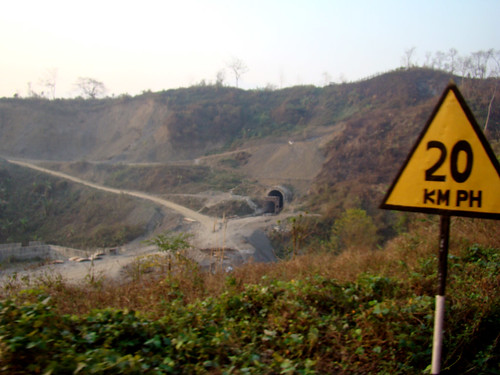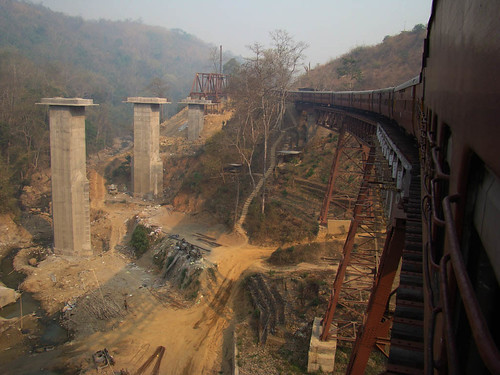It's a Long Way to Tipperah
by Mohan Bhuyan
2010-03-01
Folks, this trip took place in March this year but as is usual with me, I stopped writing midway through this report and took a two month break!
Many of you will probably be annoyed that quite a bit of this particular report has little to do with trains. But I'm of the opinion that trip reports should also try and give some idea of the region being covered and its many flavours. Besides, I have taken greater liberty in this instance because this report is about Tripura, a state that many of us are unlikely to ever visit. Many thanks to Harshu Dinesh, whose recent adventures in the NC Hills, Cachar and Tripura provided the inspiration to finish the report.
It's a Long Way to Tipperah
"From Gauhati, it will take me 24 hours to reach Agartala by bus and then a further 7-8 hours to my post in South Tripura."
These words were uttered in Hindi by a Malayali BSF constable about 66 excruciating hours into a train journey that still had another 10 hours to be endured. It was May 1994 and the Trivandrum -Guwahati Express was hell bent on breaking its own record for the longest time taken to cover the 3552 km distance between the two state capitals that have little else in common.
By the time the BSF man had made his rather matter of fact observation I was a spent force â€" staring silently out of the window at nothing in particular. All rail fanning thoughts and actions had long been burnt to a crisp by the cauldron that had been the Coromandel Coast. And the interminable, unexplained halts that the extremely-late-from-the-start TG Express had been subjected to at every divisional boundary had been more salt to my wounds. I was feeling rather sorry for myself and I didn't want to see another train in my life again. Until the constable spoke up and made me realize that others had it far worse. To spend another 30 hours in buses crossing nausea inducing hills after 75 dreary hours on a train was unimaginable hardship and I swore then that if I ever decided to go to Tripura, it would be by air.
I cringe at the memory as the Indigo flight from Delhi banks over the Bangladeshi town of Comilla. Thankfully I am about to keep my own promise and the closest I will come to a bus is the Airbus 320 I'm flying in. Agartala's airport is unusual because the end of the runway is just meters from the Indo-Bangla border so the entire descent and approach is in Bangladeshi airspace, giving us a good look at the country. I recognize Akhaura because of its biggish junction and keep my eye on both the border hugging metre gauge railway line as well as the crazily zigzagging boundary fence until they disappear from view and we land with a nice comforting thud.
The British used to call the state Hill Tipperah and kept it at arm's length from themselves and under Maharajahs who preferred to build palaces instead of railway lines. Even the Assam Bengal Railway from Chittagong to Tinsukia wasn't generous enough to offer a short branch from Akhaura to Agartala, less than 10 km away. So for more than 60 years after Independence & Partition, the only trains that the Tripuri's could see were the ones they couldn't catch. After a 25 year struggle, a meter gauge track laid on a broad gauge bed finally reached Agartala in June 2008 and that's what has drawn me to this far flung and arguably the most unknown of all Indian states.
Agartala is nondescript and even boring (no bars, so BYOB), but unlike other eastern towns there is little squalor. The Bengali that is spoken here is the kind that would make the "bhadralok" of Kolkata turn up their noses in disdain and I'm sure a supporter of Mohun Bagan FC will be a rarity here. The city's chief attraction is the lakeside Ujjayanta Palace the former abode of the Tripura Maharajas, now the Vidhan Sabha. Imagine the Indian Museum in Kolkata with a dome and multiple cupolas and you'll get the picture. Surprisingly (because it is the state's Assembly after all) the palace is in rather poor shape and in the midst of a much needed renovation. As a result it isn't open to even the tiny complement of tourists who find themselves in Agartala, but a walk around the lake affords good views and is enough to satisfy my interest in the structure.
Since there is little else to see in Agartala I hire my hotel's Omni Van and head south towards Udaipur the old capital. The British may just as well have called the state Hillock Tipperah because the endless hillocks or "Tila's" are West Tripura's most distinguishing physical feature. The tila's are covered with either forests or plantations of sal, teak & rubber (Tripura is India's 2nd largest rubber producer after Kerala). Flat ground in between the tila's is scarce and is used mostly for growing paddy & vegetables, and also for the elegant hutments made of clay, thatch and bamboo in which most of the people stay. The majority of the population is erstwhile East Bengali, whose population has more than doubled after 1965, reducing the indigenous Tripuri tribes like the Deb Barmas (SD, RD, Somdev et al), the Reang, the Jamatiya (there are about 20 tribes in all) to a less than one third minority.
Tripura is one of three states in India where the Communists manage to hold power for long periods of time and from what I can observe on the surface during my two day visit, it isn't doing badly for it. The roads are good for the most part. Schools, local govt. offices and Primary Health Centers are open and (more importantly) manned and reforestation of the "jhumed" tila's seems to have borne results. The state also has plenty of natural gas but not much use for it â€" a pipeline through Bangladesh to industrial West Bengal would make a lot of sense, but for that we have to wait for that quality to first infuse Indo-Bangla diplomacy!
Udaipur is another nondescript town, scruffier than Agartala but redeemed somewhat by numerous lakes and tanks. At one end of the largest lake sits the old, ruined and abandoned Jagannath temple, out of the top of which grows a veritable forest of Pipal trees and creepers in what Lonely Planet slightly disingenuously calls "Angkor Vat style". Apparently this temple once housed the idol of Lord Jagannath that now resides in the eponymous temple in Puri, and must have been an impressive structure in its heyday.
Udaipur's most famous temple today is the 16th century Maha Tripura Sundari, which gives the state its name and is one of the 51 Shakti Peethas where the Goddess Sati's body parts is said to have fallen to earth (in this case her right leg). On my Driver's (an ex-army man with surprisingly poor Hindi) insistence I agree to visit but manage to placate him with a "drive by darshan" when I see from afar that the temple though old is architecturally unexceptional.
Tripura's best sight is undoubtedly the Neermahal near the town of Melagarh, west of Udaipur. It is the Maharaja's pleasure palace built on an island in the middle of a vast lake teeming with birds. Approachable only by boat the palace has been emptied of all its royal contents and is a bit PWDish in appearance (probably because it was built by the Martin Burn Co in 1930, a company more renowned for building practical every day structures rather than Taj Mahals). But the setting is quite spectacular especially when the late afternoon sun falls on the whitewashed exteriors, prompting a dazzling reflection in the lake.
Afterwards as we head back through Melagarh, we are forced to trail a protest march as it slowly wends its way through town to shout slogans at the local police station. The town itself is in the middle of a celebration for the local mystic â€" a woman known as Pagli Mashi. As the name suggests she is insane and was abandoned and uncared for until she appeared in the dreams of a local notable as a manifestation of the Goddess Kali and fulfilled a long standing wish. Whereupon he elevated her to seer status though she is unable to even feed, clothe or clean herself, much less offer blessings & sermons to her flock. I wonder how all this sits with the supposedly godless CPI cadres, many of whom are marching in front of us, preventing cars from overtaking them and creating a long tailback as a result.
On the way back to Agartala I spot a billboard with the picture of a temple superimposed on a nice shot of a green & yellow diesel jumbo pulling a tanker rake through emerald green paddies. The Billboard reads "Way to Kasba Kali Temple overlooking Bangladesh".
I've found my excursion for the morrow as my train out of Tripura only leaves in the afternoon. My Driver approves â€" he was a bit put off by my disinterest in the Tripura Sundari templeâ€" if only he knew that I have no intention of making amends at Kasba!
The Kasba Kali Temple sits atop the last hillock in Tripura and overlooks a large tank on its western side. On the other side of the tank there are some bushes, then a row of palm and tamarind trees and then the yard of Kasba station, which is in Bangladesh! As we pull into the parking lot at the bottom of the hill and in between the temple and the tank, I can see that a train with a livery akin to the Kolkata - Dhaka Maitreyee Express (white with red & green stripes above & below the windows) and sporting a few roof riders, is gliding silently to a stop at the Kasba station.
Frustratingly nothing more of the station is visible because of the foliage, so I run up the hillside looking for a better vantage point and find a govt. guest house with a large terrace at the top. Nobody is around though the fan in the office is whirring so I slip in, climb to the top floor, and open the glass & steel door to the terrace with a clang loud enough to draw an entire BSF battalion to the scene. Nobody comes to investigate however, and I step gingerly onto the terrace. The view of Kasba Station is no better than before but the section of track to the south of the station is clearly visible across some paddy fields and so are the cell phone towers of its town.
A distant whistle tells me that the Maitreyee look-alike's longish wait at Kasba is for a crossing. The new arrival is another express, northbound with a green & yellow livery (like the Garib Rath's, but better) led by a jumbo in matching livery (an alco perhaps?) like the one on the billboard. With loud blasts of the horn and without slowing down, it clatters through Kasba towards Akhaura at 70 - 80 kph.
Almost immediately the Maitreyee look-alike resumes its journey southwards towards Comilla behind another green and yellow jumbo and I am able to follow it till it disappears into the haze. I'm impressed and my long time wish of one day touring Bangladesh by rail has just received a massive booster dose!
Though border fencing is supposed to be atleast 150 yards from the actual border (or the "zero line" in Babuspeak), at Kasba the fence runs along the boundary and the Kasba Tank is a salient of sorts because it is surrounded on 3 sides by Bangladeshi territory.
When the Driver and I venture near the fence we come upon a group of Bangladeshi boys, who have come through a grove of trees right up to the fence itself. For entertainment they mimic my stance (peering into their country with hands folded across my chest like Swami Vivekananda) and exchange rude banter with my Driver in their shared dialect. A BSF sentry manning a bunker 75 yards behind and above us yells and motions us to move away. Apparently it's forbidden for us to engage in "international" conversations. There are no restrictions on the Bangladeshis â€" they can come right up to the fence and I didn't see any of their border guards or posts. All the fences, all the guns, all the binoculars sporting sentries in their sandbagged bunkers and all the paranoia, are on the Indian side.
Another BSF man who hails from UP tells me that Bangladeshis come to the fence in large numbers when the Kali Bari has a festival to gaze at revelers and picnickers on this side. As if on cue a large group of Reang youngsters and their teachers arrive in two buses and settle down to a luncheon of rice and a dry vegetable. The constable mutters in a tone of disdain, "Dekho yeh log kaise sukha chawal kha sakte hain" (see how they can eat rice without a dal or a curry). The irony doesn't elude me â€" the people on this side are as much aliens to this border guard as are any on the other side!
Agartala's gleaming new railway station on the southeastern outskirts of town is an ersatz Ujjayanta Palace and as such a pleasing exception to the kind of stolid railway buildings that are the norm today.
There are 3 platforms with the meter gauge tracks placed on BG ready sleepers, MACL signals, and plenty of space for a goods yard or a pit lines when Big Brother finally makes his long awaited appearance.
Everything about this station looks new and appealing except of course the trains for which it was built. Like my 5696 Agartala-Lumding Express comprising of a lube stained YDM4 in dark blue with a red stripe livery and about 15 shabby maroon carriages.
As I stride down the platform I can't help but compare this train to the smart Bangladeshi ones I saw earlier. They have embraced their MG network, while we are so embarrassed about ours that we can't wait to consign it to the dustbin!
Whenever I make a reservation on NFR I am usually assigned to the worst carriage in the train, no doubt as ethereal revenge for several uncharitable remarks and observations I've made in the past. Today is no exception - the toilet smells, the middle berth hangs so low that one has to lie absolutely prone on the lower berth at night, the fans don't work and the window shutter doesn't slide all the way to the top restricting my view somewhat. What's more the aisle has been commandeered by unreserved paramilitary troops going on leave and there is a dog sitting quietly under my seat.
The dog in question is a well groomed, collar sporting, tawny Labrador tied with a leash to one of the railings in the window. He's no ordinary mutt but an official bomb sniffer of the Assam Rifles on transfer from Agartala to Jorhat, so I will call him K-9. When his handler appears I suggest gently that K-9 should be in the brake van but he says that it's alright for a "sarkari" pooch to travel in Sleeper Class. Nobody demurs so I resist from making a fuss and sit down, but my discomfort grows. An image of K-9 peeing happily on my shoes flashes through my head, then the window shutter falls suddenly almost breaking said head, a jawan blocks the corridor with a huge trunk, the sweat drips from my brow in torrents - and I finally succumb to the temptation I have been resisting ever since I booked my ticket. Grabbing my bag I head for the lone 2 AC carriage and ask the conductor if there are any berths to spare. "Just the one? I'll take it, thank you!"
But stepping inside I notice that the windows are almost opaque and the bustle on the platform is barely visible. That decides it so I head back to my original Sleeper after two minutes, ignoring the dirty look that the conductor throws at me. K-9's look when I return is rather more friendlier, reminding me that it makes sense after all to have a bomb sniffer in your carriage on a train in the Northeast!
That many people in Tripura are still to get used to the ways of train travel is amply demonstrated by two gents sitting across from me. They have been busy shooing off anyone who so much as leans on their berth, saying that it is theirs. Then more claimants for those seats show up just minutes before departure and it turns out that the two gents from Agartala have no idea about that thing called reservation! They beat a hasty retreat pursued by mocking laughter from our bay.
5696 departs on time at 2 o'clock, much to the relief of my paramilitary co- passengers who are all worried about onward connections from Lumding and Guwahati. In fact onward connections (and various permutations thereof) will dominate conversations in our bay all the way through. These troops have a long way to go before they reach their homes in Bihar, UP, Haryana and Rajasthan and complain that uncertain connections take big chunks out of their allotted furlough. Of course NFR does its best by detaining them further at Lumding for almost an entire day, but that's another story. In the mean time I manage to coax the shutter into resting on some unseen protrusion and with K-9 sitting quietly at my feet, I sit back to enjoy one of Indian Railways' last frontiers,
After skirting the city's southern and eastern neighbourhoods the new line from Agartala heads out on a slightly northeasterly heading. Tripura's hill ranges run in parallel lines from south to north, with the lower "Tila's" overlooking Bangladesh and the higher ranges such as the Longtarai and the Jampui to the east. These in turn merge with the Lushai Hills of Mizoram to the east and the Chittagong Hill Tracts to the south, so that there is an unbroken series of ranges stretching from the Indo-Bangla border all the way to the heart of Burma. Though the railway has to cut right across all five of Tripura's ranges, nowhere is the elevation more than a thousand meters above sea level. So it will be interesting to see how the line dealt with the topography and why it took so long to construct.
All the nice trappings of BG are in evidence in the newly built section up to Manu â€" a solid permanent way, concrete sleepers with double pandrol clips, MACL signals, the preference for over-bridges instead of level crossings, etc. and so we can clip along merrily at MG's top speed of 70 kph. But BG also deals with West Tripura's tila's with its customary finesse â€" huge 30 feet embankments (probably the highest I've seen) cut across the paddy fields between the tila's, of which the higher ones have been sliced open with what appear to be giant axe blows and then coated with cement, as a kind of antiseptic cream for the wound inflicted. So the line isn't as pretty as it ought to have been.
The run to Teliamura is uneventful, partly through rural areas but mostly through hilly forest and sparsely inhabited territory. 5696 stops at nearly all the stations on the run to Kumarghat but there aren't many passengers waiting to board at most of the initial places. The first tunnel (of three in the newly opened section) is near Jirania and burrows through the Baramura Range in a distance of 1100 meters. At Jirania the Dharmanagar- Agartala Passenger is waiting for us it and it strikes me that I could have taken an earlier train out of Agartala and seen all of the Tripura section in daylight. I have been under the mistaken impression that only two trains operate to Agartala, - 5695/ 6 Express and the 863/4 Passenger to Silchar at 12 noon. In reality there are three more passenger trains to Dharmanagar, the state's gateway to the rest of the country. By taking one of these I could have waited for 5696, which is the second last train of the day, at Dharmanagar and seen the entire stretch properly.
After Teliamura, the railway crosses the south to north flowing Khowai River and plunges into the Atharamura Range, the second of five parallel ranges it has to cross before the plains of the Barak Valley can be attained. While the ranges aren't lofty at all and certainly the climate is far from cool; they do present some degree of difficulty to builders of railway lines, especially to the BG lovers among them.
The BG lovers have dispensed with the Atharamura with a single long tunnel (1862 m) and countless cuttings but this one tunnel took such a long time to build that it was the primary reason why Agartala's advent into India's Railway Map took place only in 2008, though the line had been sanctioned way back in 1984. Even so, Agartala claims to be the first state capital to receive a rail connection after Independence, having beaten Srinagar to that dubious honour by a week.
Ambassa is the headquarters of Tripura's newest district Dhalai, which also has the distinction of having a more evocative name than the other three districts of the state (which are North, West and South Tripura). This is also the first station where there is a substantial exchange of boarding and departing passengers, with many of the latter being unreserved day trippers on their way home from the capital.
After Ambassa the line takes on the Longtarai Range, another area of hilly jungle and sparse habitation, ideal for "doorplating". The longest tunnel on the line, the 1962 m Longtarai Tunnel evokes the usual howls` and whistles from the younger passengers. The tunnel acoustics are such that they sound like a pack of jackals and for a second I fear K-9 will be roused from sleep into frenzied barking. No doubt having grown up on strict military discipline, he doesn't even look up.
We cross the Manu River quite some time before the eponymous station; it is one of the state's major rivers and flows from south to north to eventually join the Barak near Moulvi Bazaar in Bangladesh. Built as a crossing station, Manu has no additional buildings and godowns that can hark back to its temporary status as the Tripura terminus between 2002 and 2008. There aren't any passengers for us either.
The Sakhan range between Manu and Kumarghat ought not to have posed much of a problem for the engineers as there are no tunnels in this stretch. But it still took about 5 years (1997-2002) to complete the 21 km run, which is also the longest block section on the line.
At Kumarghat we wait for a long time for a crossing with the 863 Silchar-Agartala Passenger and many people take the opportunity to stretch their legs a bit. K-9 is taken for stroll and for the first time he looks happy. He's by far the most well behaved dog I've met â€" I've even trod on his tail and paw a couple of times but he hasn't let out so much as a whimper.
A brief encounter with our Driver elicits the following information: he will drive all the way to Badarpur Jn and not Karimganj as I had thought, a very long haul in terms of duty hours if not distance covered. Maximum speed thus far has been 70kph but will reduce to 65 kph hereon with some stretches of 50 kph on the older sections of the route closer to Karimganj.
Kumarghat has a single long platform with a double storied station building, a floodlight mast, an overhead water filling system for passenger trains and a goods shed. It was the terminus for 12 long years between 1990 and 2002 hence all the accoutrements. Today the yard is being widened on the eastern edge by cutting into the hillside and I climb up to the top of the resulting 30 foot cliff face to get a panoramic view of the station and also to escape the attentions of the many policemen in the station, who would no doubt invoke national security on seeing my camera.
The sun sets during our long halt at Kumarghat and this being the northeast, darkness sets in quickly. The Jampui Range is Tripura's highest range, though it would look like parallel rows of pimples in comparison with any Sub Himalayan range. Nevertheless it did pose some degree of difficulty for the railway, forcing it to take 6 years (1984-90) to reach Kumarghat from Dharmanagar, some 33 km and two stations away. This section is ideal for train chasers â€" hills, forests, tunnels and NH 44, or the Assam-Agartala Road as it is called in these parts, never too far away. At one point the railway enters a tunnel right beneath the road â€" an ideal spot for photography.
It is pitch dark well before we reach Dharmanagar, reaffirming how badly planned this particular trip has been (note to other rail fans â€" do remember to match your future trips with the phases of the moon!). The town has been Tripura's main railhead since 1964 when the line was extended southwards from Kalkalighat in Assam, and a number of warehouses and a couple of parked goods rakes are testament to that. Dharmanagar also signals the beginning of NFR's usual scruffiness â€" grimy platforms, smelly yards and semaphores (nothing wrong with that except that they are unlit). More passengers join us resulting in K-9's unfortunate eviction from our bay â€" "Kutta ko hatao baba, haamko bohut dorr lagta hai!" (Remove the dog please; it frightens us â€" delivered in a thick Bengali accent). K-9 leaves without a murmur, dignity intact.
The long run to Karimganj Jn is covered in near total darkness but for the powerful flashlights of the RPSF party guarding the train. Positioned at the doors, they use the flashlights to scan the grounds on either side of the track and also to give "all is well" signals to each other. The unreserved jawans in the corridor have lowered the shutters so there is nothing to see on the other side and monotony descends. The only highlight of this part of the journey is a crossing with a loaded goods train heading south to Tripura, for which we are made to wait for a long time at Baraigram Jn. Speeds have been generally low from Dharmanagar onwards so we are late by an hour and more.
The CRPF jawan sitting across from me strikes up a conversation. He's going on leave to his home in Bihar (troops on the Up trains to the NE are less chatty). He's done two tours of duty each in Kashmir and Assam and now his unit is in Tripura, which he doesn't much like. He prefers Assam (that's a first!). I'm no fan of the CRPF â€" its methods of containing civil strife are mostly brutal and usually counterproductive â€" but you've got to feel some sympathy for these ordinary jawans. My companion has never been posted in an area of relative tranquility in the ten years he's been in the force. He says there is only one thing that allows a jawan to emerge unscathed from months of guard duty in Lal Chowk, Srinagar (the most frequently attacked police post in India) â€" luck!
Karimganj is announced by the arrival of the Badarpur & Silchar line from the east. We are greeted by a lowered but unlit semaphore â€" I haven't seen a properly lighted signal since we left the MACL's behind at Kumarghat and I wonder what the Drivers make of that. A reversal is required at Karimganj so the halt is a long one allowing vendors to sell dinner packets to the passengers. I make do with biscuits and water.
Thanks to generous slack built into the time table, we are only about half an hour late at Badarpur, where a fresh crew will take over for the first part of the Hill Section to Lower Haflong. By my reckoning the departing crew has been on the job for almost 9 hours! The last thing I see before drifting off to sleep is a nearly completed BG bridge across the Barak. The piers were being built when I last came this way in Nov 2003, and it still isn't ready!
After an uncomfortable night I wake up just as the train is leaving Lower Haflong. Daylight at Haflong doesn't bode well; we are late by over two hours and many passengers on board are going to miss the connecting Brahmaputra Mail at Lumding. Thankfully I've slept though all the long halts that no doubt were inflicted on us at places like Harangajao, where a banker is attached for the 1:37 haul to Jatinga.
When we emerge from the bowels of the Haflong Ridge onto the Doyang Viaduct, I gasp audibly and reach for the camera. Across the way, the concrete piers of the new BG Doyang Viaduct have thrust their way upwards from the floor of the valley looking like gigantic golf tees on some unkempt course. The new bridge is going to take BG on a very different alignment from the old one, scared away by the 1:37 grade and the numerous tunnels of the latter.
5696 only has one stop between Lower Haflong and Lumding (Maibong) but it slows down so much at some of the stations that it wouldn't hurt to have a halt at the bigger places like Mahur and Langting. Having been plagued by Dimasa insurgents going by the rather melodramatic name of the Black Widow through much of 2008 and 2009, NFR has closed quite a few of the small crossing stations such as Phiding and Wadrengdisa. Yet train management seems to have improved because though we have 4 crossings (including one with the Up Barak Valley Express), we are not inordinately delayed for any of them by the longer block sections. The line is liberally sprinkled with caution orders so train speed remains modest, but perceptibly quicker than what I remember.
Though I am at the door most of the time, the once picture perfect Hill Section no longer soothes the soul. BG has turned it into an enormous construction site and the paramilitaries too have played their part by turning the valley into a fortress with numerous makeshift camps. Between Phiding and Daotuhaja, where the MG resorts to an elaborate and graceful switchback to gain a couple of hundred feet in height, the haze hangs heavy over the scene as if ashamed to reveal the havoc that has been wreaked beneath.
In trying to emulate MG over the switchback, space hogging BG has laid the Mahur Valley and the ridge above it to waste.
Conversation in my carriage isn't about such niceties however as missed connections is the primary preoccupation. A quick escape from the Northeast on the Brahmaputra Mail at 0730 is now not possible for my CRPF and BSF friends. There is the twice weekly New Dibrugarh- Kamakhya Special at 1315 today on which I am booked. Otherwise there are no decent trains between the Brahmaputra Mail and the evening Jan Shatabdi. So passengers of the from Cachar & Agartala Expresses are usually dealt double blows by NFR â€" once with the usually slow and badly delayed MG journey and then again with an all day wait at Lumding for a train to Guwahati and beyond.
Other than the Doyang Viaduct, the Hill section has two other notable bridges, which I have always missed capturing on camera during previous journeys. One is the bow shaped Dhanuk Bridge one of the few through truss bridges on this line, which I miss yet again. The other is the curved Boila Bridge, site of a 2007 tragedy when a section of the deck collapsed plunging a goods train into the 100 foot gorge.
As it nears Lumding, 5696 stops a couple of times for no apparent reason. This reluctance to reach the destination is a normal phenomenon with NFR. On two occasions before I have reached the outskirts of Guwahati on time all the way from Delhi only to be delayed by an hour or two before reaching the main station. Today I have ample time for my connection so I don't need to fret (yet), but it is annoying when an express doesn't run like an express.
Just before Lumding South where we are to join the main line, a near-completed stretch of BG track emerges from the north. This is the Lumding bypass which will do away with the reversal for the hill section when conversion is completed in 2012 or so. Later I notice that there is much construction activity at Patharkhola the first station to the west of Lumding on the main line. No doubt running rooms and a holding yard will be seen here once gauge conversion is completed.
At Lumding the main MG platform is occupied by a ready-to-depart new train called the Hill Queen, which does a quick dash to Haflong and back during the day. It includes an almost empty AC Chair Car in its complement and seems ideal for someone who wants to sample the Hill Section but doesn't have the time to go all the way. As the horde of passengers head down the platform towards the waiting areas and the BG platforms, I spot a golden brown form flitting nimbly through a forest of legs and baggage. It's my last glimpse of K-9, bomb sniffer extraordinaire, on transfer to Jorhat.

